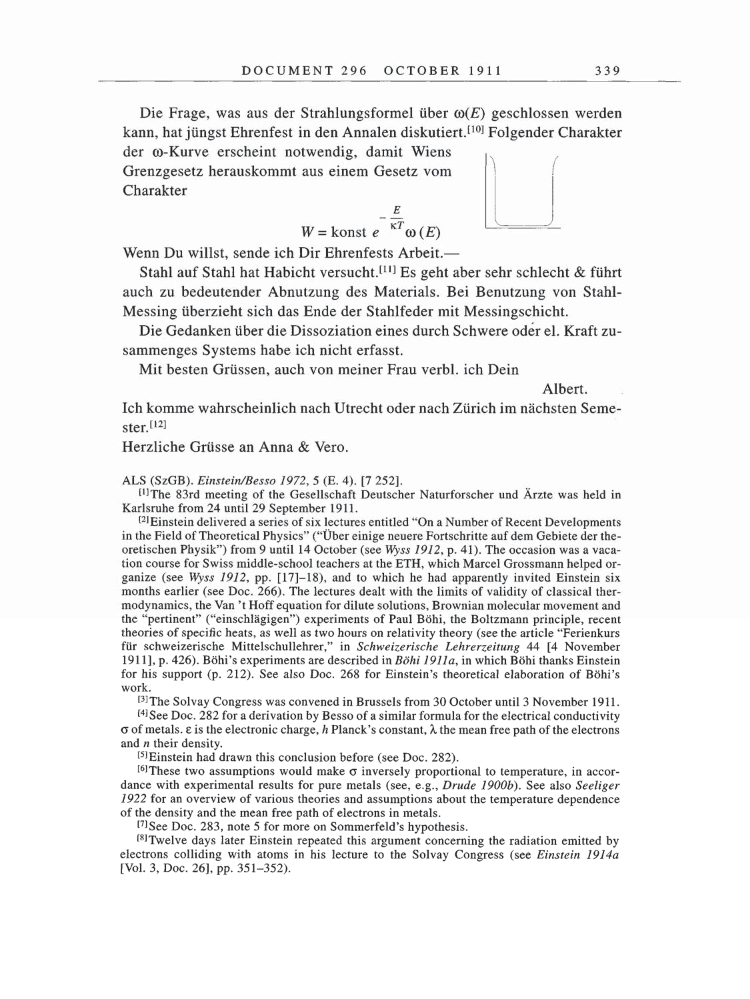DOCUMENT 296 OCTOBER 1911 339 Die Frage, was aus der Strahlungsformel über co(E) geschlossen werden kann, hat jüngst Ehrenfest in den Annalen diskutiert.[10] Folgender Charakter der co-Kurve erscheint notwendig, damit Wiens Grenzgesetz herauskommt aus einem Gesetz vom 1 / Charakter E W = konst e kT(0 (E) Wenn Du willst, sende ich Dir Ehrenfests Arbeit.- Stahl auf Stahl hat Habicht versucht.[11] Es geht aber sehr schlecht & führt auch zu bedeutender Abnutzung des Materials. Bei Benutzung von Stahl- Messing überzieht sich das Ende der Stahlfeder mit Messingschicht. Die Gedanken über die Dissoziation eines durch Schwere oder el. Kraft zu- sammenges Systems habe ich nicht erfasst. Mit besten Grüssen, auch von meiner Frau verbl. ich Dein Albert. Ich komme wahrscheinlich nach Utrecht oder nach Zürich im nächsten Seme- ster.[12] Herzliche Grüsse an Anna & Vero. ALS (SzGB). Einstein/Besso 1972, 5 (E. 4). [7 252]. [1]The 83rd meeting of the Gesellschaft Deutscher Naturforscher und Ärzte was held in Karlsruhe from 24 until 29 September 1911. [2]Einstein delivered a series of six lectures entitled "On a Number of Recent Developments in the Field of Theoretical Physics" ("Uber einige neuere Fortschritte auf dem Gebiete der the- oretischen Physik") from 9 until 14 October (see Wyss 1912, p. 41). The occasion was a vaca- tion course for Swiss middle-school teachers at the ETH, which Marcel Grossmann helped or- ganize (see Wyss 1912, pp. [17]-18), and to which he had apparently invited Einstein six months earlier (see Doc. 266). The lectures dealt with the limits of validity of classical ther- modynamics, the Van 't Hoff equation for dilute solutions, Brownian molecular movement and the "pertinent" ("einschlägigen") experiments of Paul Böhi, the Boltzmann principle, recent theories of specific heats, as well as two hours on relativity theory (see the article "Ferienkurs für schweizerische Mittelschullehrer," in Schweizerische Lehrerzeitung 44 [4 November 1911], p. 426). Böhi's experiments are described in Böhi 1911a, in which Böhi thanks Einstein for his support (p. 212). See also Doc. 268 for Einstein's theoretical elaboration of Böhi's work. [3]The Solvay Congress was convened in Brussels from 30 October until 3 November 1911. [4]See Doc. 282 for a derivation by Besso of a similar formula for the electrical conductivity g of metals. Ģ is the electronic charge, h Planck's constant, X the mean free path of the electrons and n their density. [5]Einstein had drawn this conclusion before (see Doc. 282). [6]These two assumptions would make g inversely proportional to temperature, in accor- dance with experimental results for pure metals (see, e.g., Drude 1900b), See also Seeliger 1922 for an overview of various theories and assumptions about the temperature dependence of the density and the mean free path of electrons in metals. [7]See Doc. 283, note 5 for more on Sommerfeld's hypothesis. [8]Twelve days later Einstein repeated this argument concerning the radiation emitted by electrons colliding with atoms in his lecture to the Solvay Congress (see Einstein 1914a [Vol. 3, Doc. 26], pp. 351-352).
